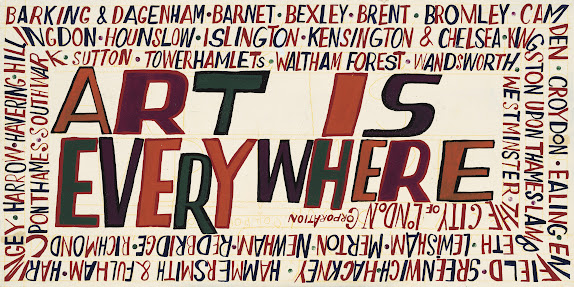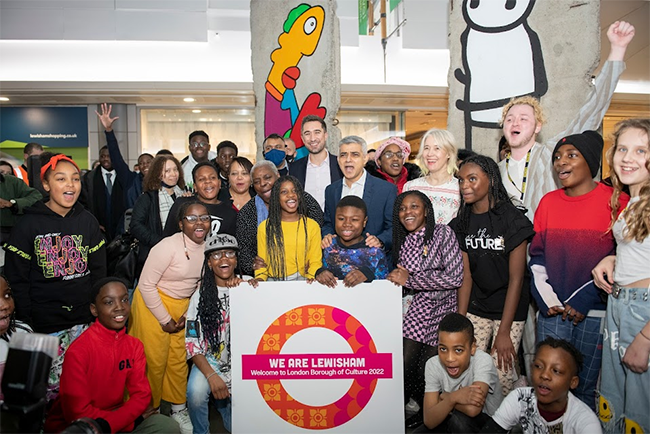Recognising the pressing need for communities to reach out to their neighbours, London Borough of Culture is a celebration of the unique character, people and heritage of London’s boroughs.
Introduction
The Mayor of London, Sadiq Khan, launched London Borough of Culture in 2017 as an ambitious cultural programme, underpinned by the active engagement of residents, to put culture at the heart of local communities, inspire new talent and creativity, and draw visitors from across the city and beyond.
Recognising the pressing need for communities to reach out to their neighbours, London Borough of Culture is a celebration of the unique character, people and heritage of London’s boroughs.
Five years on, it’s proven to be a game-changer for the capital. It has transformed communities, transformed councils and shown the power of having culture on every doorstep.
The challenge
Culture is London’s DNA, part of our identity as a city. Prior to Covid-19, it brought £58.4 billion to our economy each year, one in every six jobs in the capital was a creative one, and four out of five visitors to London came because of its culture. But only a third of Londoners access our cultural riches. So, the vision for London Borough of Culture is to open up culture for all Londoners.
Public funding for culture also continues to plummet. Council expenditure on cultural services has fallen by 50 per cent across England since 2010 (£118 per person in 2010 falling to £59 today).
One of the aims for London Borough of Culture was to shine a spotlight on boroughs, supporting them with funding, partnerships and profile – enabling them to leverage additional funding and sustainably embed culture across all aspects of council activity from economic development and regeneration to social inclusion and education. We wanted to support grassroots arts organisations; amplifying their work to help them reach deeply into the communities they serve, and also to build partnerships to ensure a strong, secure future.
We know that one of the factors that can drive young people towards criminal behaviour is a lack of access to constructive, engaging activities. Youth services have been hit hard, over 100 youth centres having closed since 2011. Cultural programmes create a sense of community for young people, provide access to training and jobs and showcase future career paths. We wanted London Borough of Culture to create initiatives aimed at engaging at-risk young Londoners, and to support work and research looking at how culture and creativity can support young people’s mental health and wellbeing.
The solution
London Borough of Culture is a powerful partnership model, aiming for culture and creativity to be embedded across council policy and strategy, becoming integral to life in the borough.
London boroughs submit bids to receive £1.35 million to create a year-long programme of activities celebrating the unique character of local people and places.
The winning boroughs are supported to bid for funds that have been agreed by partners Paul Hamlyn Foundation and National Heritage Lottery Fund, and from Arts Council England. These and other organisations form a Strategic Partners Board. Boroughs are expected to provide at least 30 per cent match funding (25 per cent cash, five per cent in kind).
There have been two rounds so far. In 2019, Waltham Forest was the first ever London Borough of Culture, and in 2020, Brent took the title.
Announced at the same time were six Cultural Impact Awards, which received over £1 million for transformative projects in the boroughs of Barking & Dagenham, Camden, Kingston, Lambeth, Lewisham and Merton.
Lewisham is London Borough of Culture for 2022, Croydon takes the title in 2023, and Hammersmith and Fulham, Haringey and Sutton have Cultural Impact Award projects taking place in 2022-2024.
The successful boroughs demonstrated step change, positive impact on local communities, ambition and authenticity. Applications were assessed against rigorous criteria under three categories: making an impact; celebrating creativity and deliverability. An interview stage was introduced in round two for more in-depth assessment of proposals. Policy teams across the GLA (Greater London Authority) commented on applications and the panel was made up of GLA representatives and three independent members from the creative sector.
Boroughs are supported through their development period, year of culture and legacy delivery by the GLA’s Culture and Creative Industries team and colleagues from across the GLA; helping to broker partnerships and secure funding; supporting with profile, communications and evaluation, to secure a strong legacy for the borough and their communities.
The impact
London Borough of Culture has leveraged more than £16.8 million from over 20 funders. It supports work designed and led by local people, empowering communities and contributing to the health and wellbeing of residents. So far, it has benefitted twelve boroughs, supporting the development of outstanding creative work for people in areas where cultural participation is low.
It has created opportunities for the artistic community, including creative freelancers and grassroots organisations hard hit during the pandemic – working with over 2,000 artistic partners across London. It has increased access to high quality culture and creative activities, with opportunities to develop skills, find jobs and improve prospects – with 208 schools involved, 1,570 people signed up as volunteers and 600+ employment, development and leadership opportunities created for young people.
London Borough of Culture has helped boroughs to boost their local economy and raise their profile – for example, in Waltham Forest £4.1 million was spent by audiences over ten major events, with 83 per cent of attendees spending money locally. Seventy per cent of local creative businesses reported increased revenue. And in Brent during 2020, they achieved a fantastic 308.7 million reach across social media, with 649 items of media coverage, and an audience of 843,481 (209,338 live and 634,143 digital)– despite their programme taking place during two national lockdowns!
Cultural Impact Award projects also have a significant legacy. Barking and Dagenham’s pioneering new programme to bring the power of art and culture into social care services received a further £1 million from the Mayor’s Violence Reduction Unit, and continues to support artists, social care staff and carers to work together to transform care services.
ELEVATE in Lambeth, a programme to support diverse creative talent, is now a central part of the council’s cultural strategy. Most recently they launched ELEVATE Careers, paid opportunities for 16 to 30-year-olds from employers interested in diversifying their workforce and benefiting from a hyper-creative generation.
How is the new approach being sustained?
We have built and managed strong and strategic relationships with the boroughs and continue to advocate for them, their legacies and the legacy of London Borough of Culture more broadly within the GLA and across the city. It has not been a typical funder/ grantee relationship but rather a collaborative endeavour, where we support boroughs with their internal as well as external facing engagement and advocacy.
This support includes signposting to other opportunities; for example, Waltham Forest was chosen to host the pilot for the Mayor’s Night Time Enterprise Zones in 2020; this was successful and a programme has recently been opened to all boroughs. Waltham Forest became the first accredited Creative Enterprise Zone, and they also successfully bid to become lead for the Creative Industries Hub, part of the Mayor’s Academy programme. Some other legacy highlights include:
-
The redesign of Fellowship Square – a new public space with interactive fountains, free and low-cost events, art installations and performances all year round.
-
Growth of the Legends of the Forest volunteer scheme; with numbers tripling to 3000 and proving vital to the council’s COVID response.
-
Continuation of the Make it Happen community grants scheme with £100,000 funding for local artists and community groups.
In Brent:
-
The establishment of a new Local Cultural Education Partnership, ensuring every child in Brent has access to creative opportunities and pathways into the creative industries.
-
Creation of a pipeline of free space, meanwhile and permanent for arts and culture, which started with Metroland Studios in Kilburn with fourteen studios made available for artist residencies.
-
Metroland Cultures, who, with a £1 million investment from the council, are building on the success of the public art programme, the Brent Biennial and delivering a music biennial alongside it, as well as career development for local artists and young people.
-
Development of the Artist Network, a group of more than 400 local creatives.
Lessons learned
Six key lessons
There is a big appetite from boroughs for this programme. Twenty-two boroughs applied in 2017 and 24 boroughs engaged in 2019. Boroughs who did not apply gave feedback that the engagement process was hugely beneficial, helping them to build partnerships, develop thinking and was fundamental to embedding culture corporately.
London Borough of Culture has economic and social value. In Waltham Forest, the restoration of a local cinema into a 950-seat arts venue and cultural hub operated by Soho Theatre, is estimated to bring £52 million to the local economy in the next decade. An example of social value is EastSide Story, developed and performed by 22 young people from two estates in Waltham Forest. Of this cohort, two returned to mainstream education from a pupil referral unit. Two joined the council’s Youth Advisory Group, one went on to university and one started a full-time media apprenticeship.
Partnership is immense! As well as over 2000 artistic partners across the programme, we work directly with a Strategic Partners Board including Arts Council England, City Bridge Trust, City of London Corporation, London Councils, National Lottery Heritage Fund, Historic England, Libraries Connected, Paul Hamlyn Foundation and The Linbury Trust.
The ambition of London Borough of Culture, supported by funding, gave boroughs the opportunity to try new things, for example, the pioneering work happening in Barking and Dagenham, with the development of a new vision for creative social work.
We have also learnt that this isn’t just a culture initiative, it is breaking down siloes. The leader of Waltham Forest said the experience was ‘life-changing for the council’ and the Chief Executive of Brent said they now have culture running through their DNA.
And lastly, we have seen that the successful projects managed to engage with top class artists and the community. For example – Sir Matthew Bourne’s New Adventures dance company worked with all 550 pupils of Roger Ascham Primary School in Walthamstow to dance a performance of The Nutcracker.
What didn’t work? Boroughs wanted more time – we listened and moved to a biennial model. And more money - continued austerity is a huge challenge for councils and annual budget setting makes planning ahead challenging.
Contact
Angie Farrance, Senior Programme Coordinator, London Borough of Culture
Email: [email protected]


